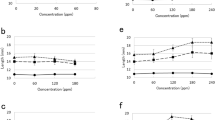Abstract
The dependence of morphogenetic processes in the formation of vegetative and generative organs in spring oilseed rape and barley on exogenously applied physiological analogues of auxin: 2,4-D (2,4-dichlorphenoxyacetic acid), NAA (naphthalene-1-acetic acid), TA-12 (1-[2-chloroethoxycarbonyl-methyl]-4-naphthalenesulfonic acid calcium salt) and TA-14 (1-[2-dimethylaminoethoxicarbonylmethyl]naphtalene chlormethylate) were investigated. The experiments were performed with hypocotyl tissue cultures of oilseed rape and barley microspores in vitro. The auxin analogues applied revealed differences of morphogenetic competence in dedifferentiation-redifferentiation processes that occurred in oilseed rape cultures. TA-12 and TA-14 applied together with NAA and BA (6-benzylaminopurine) caused more intensive callus growth in comparison with 2,4-D. Rhizogenesis was induced when 2,4-D was substituted by TA-12. Compound TA-14, unlike TA-12, facilitated the appearance and development of cotyledons in callus tissues. Hower the compounds TA-12 and TA-14 have no positive effect in monocot plant — barly anther culture for callogenesis and regeneration in comparison to indole-3-acetic acid (IAA). TA-14 and TA-12 showed similar but not identical auxin properties and demonstrated high efficiency as modifiers of rape-dicot plant growth and morphogenesis.
Similar content being viewed by others
Abbreviations
- BA:
-
6-benzylaminopurine
- 2,4-D:
-
2,4-dichlorphenoxyacetic acid
- TA-12:
-
1-(2-chloroethoxycarbonylmethyl)-4-naphthalene sulfonic acid calcium salt
- TA-14:
-
1-(2-dimthylaminoethoxicarbonylmethyl)naphthalene chlormethylate
- IAA:
-
indole-3-acetic acid
- NAA:
-
naphthalene-1-acetic acid
References
Adam E., Kozma-Bognar L., Scharfer E., Nagy F. 1997. Tobacco phytochromes: genes, structure and expression. Plant, Cell and Environm. 20: 678–684.
Andersen S.B., Due I.K., Olsen A. 1987. The response of anther culture in a genetically wide material of winter wheat (Triticum aestivum L.). Plant Breed., 99: 181–186.
Arezki Q., Boxus Ph., Kevers C., Gaspar Th. 2000. Hormonal control of proliferation in merismatic agglomerates of Eucalyptus Camaldulensis Dehn. In Vitro Cell. Dev. Biol. — Plant, 36: 398–401.
Caredda S., Clement C. 1999. Androgenesis and albinism in Poaceae: influence of genotype and carbohydrates. In: Anther and Pollen: from biology to biotechnology: 211–228.
Caredda S., Doncoeur C., Devaux P., Sangwan R. S., Clement C. 2000. Plastid differentiation during androgenesis in albino and non-albino producing cultivars of barley (Hordeum vulgareL.). Sex Plant Reprod., 13: 95–104.
Dunwell J. M., Francis R. J., Powell W. 1987. Anther culture of Hordeum vulgare L. A genetic study of microspore callus production and differentiation. Theor Appl Genet., 74: 60–64.
Gavelienė V., Novickienė L., Miliuvienė L., Brazauskienė I., Kazlauskienė D. 2005. Possibilities to use growthe regulators in winter oilseed rape growing technology. 2. Effects of auxin analogues on the formation of oilseed rape generative organs and plant winterhardiness. Agronomy Research, 3: 9–19.
Hobbie L. J. 1998. Auxin: molecular genetic approaches in Arabidopsis. Plant Physiol. Biochem., 36: 91–102.
Jacquard C., Wojnarowiez G., Clement C. 2003. Anther culture in barely. In: Doubled haploid production in crop plants. Springer, Berlin, Heidelberg, Tokyo: 21–28.
Mackevičius J., Novickienė L., Pudanaitė J. 1999. The effect of physiological analogues of auxin on growth and development of some cruciferous plants. Biologija, Lithuania, 1: 53–56.
Mannienen O. 1997. Optimizing anther culture for barley breeding. Agricult. & Food Science in Finland, Vol.6. N.5/6: 389–398.
Merkys A. 1982. Auksin i rost rastenij [Auxin and plant growth]. Vilnius, Mokslas: 198 (in Russian).
Merkys A., Novickienė, Miliuvienė L., Šaltytė Z. 1993. New growth regulators and evaluation of their physiological activity. 2. Compounds of auxin. Biologija, Lithuania, 4:54–56.
Miliuvienė L., Novickienė L. 2004. Peculiarities of the effect of dimethylmorpholinium chloride derivate. Biologija, Lithuania, 1: 45–47.
Murashige T., Skoog F. 1962. A revised medium for rapid growth and bioassays with tabacco tissue cultures. Physiol. Plant., 15: 473–497
Novickienė L., Jurevičius J. 1997. The problem of plant growth regulation and prospects of its solution. 1. Physiological analogues of auxin and pecularities of their activity. Biologija, Lithuania, 3: 61–68.
Novickienė L., Gavelienė V. 2000. Modification of spring rape growth and morphogenesis by physiological analogues of auxin. Horticulture and vegetable Growing. Babtai, Lithuania, 19: 180–192.
Novickienė L., Darginavičienė J., Maksimov G. 2004. Root initiation and development by auxin physiological analogue TA-12. Acta Universitatis Latviensis. Biology, 676: 201–206.
Polevoj V.V. 1982. Fitogormony (Phytohormones). Leningrad, Publ. Leningradskogo universiteta: 249 (in Russian).
Raklevičienė D., Kniežienė J., Šaulienė I. 2000. Modification possibilities of somatic embryogenesis with phytohormones in tissue cultures. Horticulture and Vegetable Growing, Babtai, Lithuania, 19: 390–400.
Sarrafi A., Ghaemi M. 1997. L’androgenèse et son utilisation en génétique et amelioration des plantes. Biotechnologies végétales haplodiploidisation: 45–88 (in French).
Songailienė A., Ženauskas K. 1985. Tyrimo duomenř biometrinis ávertinimas [The biometric evaluation of investigation data]. Mokslas. Vilnius: 167 (in Lithuanian).
Sugiyama M. 1999. Organogenesis in vitro. Curr. Opin. Plant. Biol. 2: 61–64.
Szarejko I. 1996. Barley and wheat anther culture: protokol for anther culture, Katowice, Poland: 14.
Zang H., Forde B.G. 2000. Regulation of Arabidopsis root development by nitrate availability. J. Exper. Bot., 51: 51–59.
Zhou W., Leul M. 1999. Uniconazole-induced tolerance of rape plants to heat stress in relation to changes in hormonal levels enzyme activities and lipid peroxidation. Plant Growth Regul. 27: 99–104.
Author information
Authors and Affiliations
Corresponding author
Rights and permissions
About this article
Cite this article
Novickienė, L., Asakavičiūtė, R. Analogues of auxin modifying growth and development of some monocot and dicot plants. Acta Physiol Plant 28, 509–515 (2006). https://doi.org/10.1007/s11738-006-0046-6
Received:
Accepted:
Issue Date:
DOI: https://doi.org/10.1007/s11738-006-0046-6




